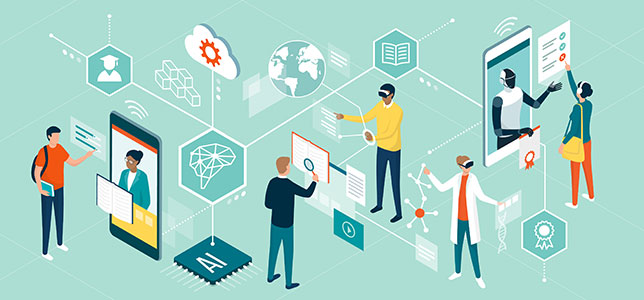The future of higher education means breaking down classroom walls, embracing digital tools and engaging students with creativity and innovation.
Necessity is the mother of invention. And within the context of a global pandemic, necessity was the mother of wholesale transformation. The monumental challenges educators overcame in 2020 is astounding. From preschool to grad school, the race to adopt and adapt online learning platforms hit a pace and scale previously unimagined.
Even at Maryville University, where we first launched online degree programs nearly a decade ago and where more than 90 percent of our on-campus students had taken at least one online class before the pandemic, the impact was still felt. We leaned on our faculty and their learning design partners to ensure no student was left behind or lost in the digital shuffle.
Now, as we consider the post-pandemic academic landscape, one thing is sure: Online learning isn’t going anywhere. To think otherwise is a massive failure of imagination.
Consider three ramifications of what we’ve all just experienced:
- Faculty and students everywhere and at every level have been immersed in digital learning practices.
- Learning tools and apps are being designed, improved and deployed at unprecedented speeds.
- Businesses in all sectors are under tremendous pressure to reskill and upskill their workforce to meet the demands of a technology-enabled future.
Viewing online learning through the narrow iris of challenge is detrimental to the future of higher education. Instead, let’s open the aperture to opportunity. Let’s harness every digital learning tool at our disposal and aggressively build pathways to connect students, faculty, staff and employers in new and profound ways.
We can fundamentally rethink the future of higher education and what it means to earn a degree if we are brave enough to do so.
The Classroom Without Walls
Prior to the pandemic, the classroom-without-walls concept was often viewed from the outside in. We harnessed digital tools like virtual reality to bring experiences from the outside world into the classroom. We extended the boundaries of the curriculum, but we were still tied to a physical classroom.
With no classrooms, all the walls fall away. The learning environment becomes any environment. At Maryville, two of our undergrads, brothers Bailey and Logan Roehr, spent their 2020 fall semester learning on the road. They packed up the family car and visited 13 national parks in 15 states, logging a total of 9,000 miles, all while actively participating and thriving in their online coursework remotely.
Extrapolate the possibilities from the ingenuity and experience of these online trailblazers. What if students could choose to learn in environments that are fully immersive, deeply enriching and profoundly meaningful to their courses of study? We encourage our students to explore the world beyond the campus, but what happens when the world is your campus?
When learning can happen anywhere, learning happens everywhere. The university evolves to become a true service, opening an entirely new universe — and university — of possibilities.
Immersed in Digital Learning
If we can break down walls, we can build new experiences that fuse the real and digital worlds together. Digital teaching and learning tools, coupled with imagination and creativity, drive our learning designers and faculty to create new ways to teach and engage students. Technology allows us to assess and embrace different learning styles and tune digital curricula to meet students where they are. And, perhaps most importantly, this integrated, immersive approach is an important leap toward bridging the digital divide and gives everyone access and opportunity to learn and excel.
Source:https://campustechnology.com/

